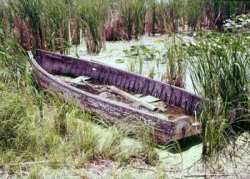 |
 |
| Home | Welcome | What's New | Site Map | Glossary | Weather Doctor Amazon Store | Book Store | Accolades | Email Us |
 | |||||||||
Weather Almanac for August 2000WIND CHIMESThe patter of raindrops, the crack and rumble of thunder, the howl of a winter gale. These are but a few of the common weather sounds which have long been a part of my enjoyment of weather "watching." I love these sounds as well as those produced by the interaction of weather elements with trees, standing water and buildings. The soft rustle of aspen leaves in a summer breeze, the chatter of dried maple leaves in autumn and the drumming of winter rain on a window pane can firmly set the weather mood in my senses or spark old memories.
Those made of metal tubes or solid cylinders produce the clearest tones and can be tuned to specific notes on the musical scale. The relative lengths to which the elements are cut determine the particular scale. Most Western music is based on a set of twelve equally spaced tones with eight notes defining one of several major or minor scales. Often, wind chimes are constructed using the pentatonic scale common to Eastern music. The advantage of the pentatonic scale is that when its notes are struck, no combination will produce a dissonant sound unpleasing to the ear. While a wind chime unit is usually constructed so that the clapper will strike no more than two elements at a time under optimum conditions, in strong and gusty winds there are many instances where more than two elements will be struck simultaneously or nearly so.
In the days before weather forecasts were available, weatherwise farmers, fishermen and others could make good short-term forecasts with a knowledge of local weather patterns and a few observations. Wind speed and direction are generally important indicators for use in such forecasts. Thus, by properly exposing a set, or several sets, of wind chimes to maximize their activation by a specific wind direction or directions, it is possible to hear the general direction of the wind. With several different sets of chimes strategically placed, different wind directions can be distinguished. For example, a high-pitched wind chime on the west side and a low pitched one on the east should distinguish between a west and east wind. In addition, the rate at which the clapper strikes the chimes can give a qualitative estimate of the wind speed. In many areas, specific weather conditions are often associated with certain wind directions. For example, along the Atlantic Coast northeasterly winds often signify a coming storm or one in progress. Westerly or northwesterly winds may indicate passage of a cold front, particularly if it is blustery. A sudden increase in wind chime activity may presage a coming thunderstorm. For those living near a large body of water in the summer, an increase in winds blowing onshore generally bring cooler conditions via a lake or sea breeze. A properly placed set of wind chimes could then alert you to open up some windows to cool a cottage or house.
Written by
|
|||||||||
 |
To Purchase Notecard, |
Now Available! Order Today! | |
 |
 |
NEW! Now |
The BC Weather Book: |


